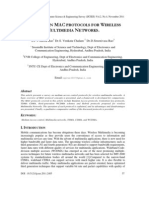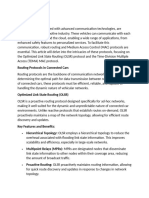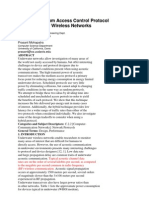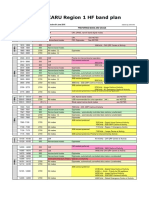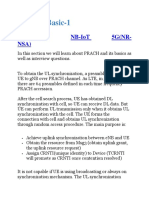0 ratings0% found this document useful (0 votes)
3 views440
440
Uploaded by
bindulayamCopyright:
© All Rights Reserved
Available Formats
Download as DOCX, PDF, TXT or read online from Scribd
440
440
Uploaded by
bindulayam0 ratings0% found this document useful (0 votes)
3 views7 pagesCopyright
© © All Rights Reserved
Available Formats
DOCX, PDF, TXT or read online from Scribd
Share this document
Did you find this document useful?
Is this content inappropriate?
Copyright:
© All Rights Reserved
Available Formats
Download as DOCX, PDF, TXT or read online from Scribd
Download as docx, pdf, or txt
0 ratings0% found this document useful (0 votes)
3 views7 pages440
440
Uploaded by
bindulayamCopyright:
© All Rights Reserved
Available Formats
Download as DOCX, PDF, TXT or read online from Scribd
Download as docx, pdf, or txt
You are on page 1of 7
ASSIGNMENT-2
WIRELESS SENSOR NETWORKS (20ECE417)
Name: L.Bindu Sree
ROLL NUMBER : 21691A0440
BRANCH & SECTION: ECE – A
1. Discuss Contention free protocol with example. How it is different
from contention-based protocol. Is TDMA a Contention free protocol?
Contention-Free Protocols
Concept:
allow only one sensor node to access the channel at any given time
thereby avoiding collisions and message retransmissions
assuming a perfect medium and environment
i.e., no other competing networks or misbehaving devices exist that could
otherwise cause collisions or even jam a channel
Contention-free protocols allocate resources to individual nodes to ensure
exclusive resource access by only one node at any given time
Exposes a number of desirable characteristics
node knows exactly when it has to turn on its radio
during all other times, radio can be turned off to preserve energy
fixed slot allocations impose upper bounds on delay
difficult to design schedules for large networks
difficult to handle changes in topology, density, traffic load
Contention-free protocols are communication protocols that avoid collisions by
scheduling access to a shared communication medium in a coordinated manner. In
these protocols, devices are granted exclusive access to the medium, ensuring that no
two devices transmit simultaneously.
Important attributes:
1. Collision-Free Communication: Guaranteed because access is explicitly managed.
2. Deterministic Access: Devices know when they can transmit.
3. Efficient for Heavy Traffic: Perform better in high-load conditions since collisions
are avoided.
Contention-free protocols include, for example, Time Division Multiple Access
(TDMA):
The communication channel is separated into time slots in TDMA.
To prevent collisions, each device is given a distinct time slot for data transmission.
For instance, cellular networks assign customers time periods for both downlink and
uplink communication.
Polling: To find out if a device has data to relay, a central controller asks each device
in turn.
Token passing is when a token moves throughout the network and can only be
transmitted by the device that is holding it.
Example: TDMA (Time Division Multiple Access)
TDMA divides the communication channel into time slots. Each device is assigned a
specific slot for transmission, ensuring no overlap.
Application: Cellular networks, satellite communication.
Contention-Based Protocols
Contention-based protocols, on the other hand, allow devices to transmit whenever
they need to, which may lead to collisions. Devices must have mechanisms to detect
and resolve collisions.
Key Features:
1. Non-Deterministic Access: Devices compete for access to the medium.
2. Collision Possible: Collisions can occur, requiring retransmission.
3. Efficient for Low Traffic: Perform well under low network load as there is minimal
overhead.
Example: CSMA/CD (Carrier Sense Multiple Access with Collision Detection)
How It Works: Devices sense the medium before transmitting. If a collision occurs,
they wait for a random time and retry.
Application: Ethernet.
Difference Between Contention-Free and Contention-Based Protocols:
Aspect Contention-Free Protocols Contention-Based Protocols
Access Scheduled, deterministic Random, competitive
Collision Handling No collisions Collisions detected and
resolved
Efficiency Better for high traffic Better for low traffic
Complexity Higher (requires scheduling) Lower (simpler mechanisms)
Examples TDMA, FDMA, Polling CSMA/CD, CSMA/CA
Is TDMA a Contention-Free Protocol?
Yes, TDMA is a contention-free protocol because it allocates fixed time slots to devices,
ensuring that only one device transmits at any given time, thus avoiding collisions
entirely.
TDMA is a protocol that does not include contention. By allocating time slots to devices,
TDMA prevents collisions and offers deterministic access to the medium by guaranteeing
that only one device transmits at a time during its given slot.
Consider a satellite communication system with three units using the same frequency as
an example of TDMA:
Device A broadcasts during Time Slot 1.
Device B broadcasts during Time Slot 2.
Device C broadcasts during Time Slot 3.
This removes competition by guaranteeing that every device has sole access to the media
during its allotted time.
Q2) (i) Discuss various types of dissemination protocol for large sensor network.
(ii) Explain Table-driven (Proactive routing).
ANS:
(i) Types of Dissemination Protocols for Large Sensor Networks:
In sensor networks, dissemination methods guarantee effective data transfer, frequently
disseminating data to several network nodes from one or more sources. These protocols
fall under one of the following categories based on the application:
Protocols for Data-Centric Distribution
Instead than using node identifiers to distribute data, these protocols use content,
including attribute-value pairs.
For instance:
Directed Diffusion: Queries that define necessary data properties are used to
spread data.
Metadata negotiation is used by SPIN (Sensor Protocols for Information by
Negotiation) to cut down on redundancy and save energy.
Use: Applicable when nodes require particular kinds of data rather than data from
particular nodes.
Protocols for Hierarchical Dissemination:
These protocols effectively distribute data by using a hierarchical structure.
For instance:
LEACH (Low Energy Adaptive Clustering Hierarchy): Information is sent
to the base station after being combined at cluster heads.
Only when threshold conditions are satisfied does TEEN (Threshold-
sensitive Energy Efficient sensor network) send data.
Use: Ideal for applications where energy efficiency is crucial and there are a lot of nodes.
(ii) Table-Driven (Proactive) Routing:
Devices can always know the way to any destination thanks to table-driven or proactive
routing protocols, which keep routing tables for every node in the network up to date.
Important attributes:
Routing Table Maintenance: Nodes keep track of all destination routes, which are
updated either on a regular basis or if the network topology shifts.
Low Latency: Data packets are sent instantly since routes are already calculated.
Increased Overhead: Especially in dynamic networks, frequent updates use energy
and bandwidth.
Scalability Issues: Because of the size of routing tables and update overhead, this
solution is not appropriate for very large networks.
Proactive Routing Protocol Examples:
1. Destination-Sequenced Distance-Vector, or DSDV, avoids loops by using a distance
vector approach using sequence numbers.
2. Nodes broadcast their routing tables to their neighbours on a regular basis.
Link-state routing with wireless network optimisations is used by OLSR (Optimised
Link State Routing).
3. shares link-state data with specific neighbours on a regular basis.
Cluster head Gateway Switch Routing, or CGSR, groups nodes into clusters and
assigns cluster heads to oversee communication within and between clusters.
Advantages:
Proactive routing has the benefit of low latency for connections that are already
established.
Route availability right away.
The drawbacks of proactive routing include:
high overhead because tables are updated frequently.
ineffective in networks that are sparse or extremely dynamic.
Q3) Elaborate about (i)Secure network Encryption Protocol (SNEP) (ii)μTESLA
Protocol
ANS:
(i) Secure Network Encryption Protocol (SNEP)
A lightweight security protocol called SNEP was created for wireless sensor networks
(WSNs) with limited resources. It offers freshness, integrity, secrecy, and verification of
data. A fundamental component of the SPINS (Security Protocols for Sensor Networks)
system, SNEP is designed to satisfy the unique needs of WSNs, including low power
consumption and constrained processing capacity.
One of SNEP's benefits is its effective utilisation of energy and computing resources.
offers several security features in one protocol.
Because it is lightweight, it can be scaled for huge networks.
SNEP applications:
networks for environmental monitoring.
networks of military sensors.
systems for smart home security.
(ii) μTESLA Protocol:
Another lightweight security mechanism that is a component of the SPINS architecture is
called μTESLA (Micro Timed Efficient Stream Loss-tolerant Authentication). It tackles
the issue of securely broadcasting data in a resource-constrained context by concentrating
on delivering authenticated broadcast in wireless sensor networks.
Advantages of μTESLA:
lightweight and effective, making it appropriate for sensor nodes with constrained
processing capacity.
Safe from unwanted broadcasts and replay attacks.
uses a single MAC per message, which lowers overhead.
Limitations of μ TESLA:
demands precise node-to-node time synchronisation.
Attacks using delayed messages could occur if synchronisation is not accurate.
Applications of μ TESLA:
Update WSN firmware securely.
IoT devices that use broadcast authentication.
vital warning systems in networks for disaster management or the military.
Q4) Explain the purpose of a gateway in a Wireless Sensor Network (WSN). How
does the gateway concept enable communication between WSNs and the internet?
Provide a basic overview of its role and significance in bridging the two networks.
ANS:
In a Wireless Sensor Network (WSN), a gateway serves as an essential bridge that links
the WSN to other networks, including the internet or other private networks. It acts as the
conduit for the transmission of sensor node data to external systems for processing,
archiving, and additional analysis. Additionally, the gateway makes it easier for external
systems to provide control orders to the sensor nodes.
Roles and Functions of a Gateway in WSN:
1. Translation of Protocols:
Sensor nodes frequently employ communication protocols (such as LoRa,
BLE, and Zigbee) that are incompatible with TCP/IP and other common
internet protocols.
These protocols are translated by the gateway, allowing the WSN and external
networks to communicate with ease.
2. Aggregation of Data:
Gateways frequently aggregate or preprocess data from several sensors before
delivering it in order to save bandwidth and increase efficiency.
3. Forwarding and Routing:
serves as a routing point to transfer information between the external network
and the WSN.
How the Gateway Concept Enables Communication Between WSNs and the
Internet
1. Interoperability of Protocols:
Whereas the internet depends on reliable protocols like HTTP and MQTT,
WSNs usually use lightweight protocols like Zigbee or LoRaWAN.
By acting as protocol converters, gateways make it possible to send and
encapsulate sensor data in formats that are compatible with the internet.
2. IP addressing:
Due to resource limitations, the majority of sensor nodes do not use IP
addresses. The gateway serves as the network's internet representative by
allocating an IP address for external communication.
3. Forwarding Data:
The gateway uses the internet to send the data gathered by the sensor nodes to
databases, cloud servers, or user interfaces.
Significance of Gateways in Bridging WSNs and the Internet:
1) Facilitates Integration of IoT:
WSN integration into the larger Internet of Things (IoT) ecosystem is made feasible by
gateways, which enable sensor data to support automation, real-time analytics, and
decision-making.
2) Accessibility from a distance:
Gateways allow users to remotely monitor and control sensor networks by connecting
WSNs to the internet.
3) Scalability:
Gateways centralise internet connectivity, making it easier to handle big WSN
deployments.
You might also like
- Eband Light Licensing White Paper V051310Document14 pagesEband Light Licensing White Paper V051310jorlugonNo ratings yet
- Report On Consumer's Perception On IphoneDocument39 pagesReport On Consumer's Perception On IphoneAbdul Qayoom82% (11)
- Computer networkDocument5 pagesComputer networkprajapatisimran557No ratings yet
- Digital Communication and Networking 222Document3 pagesDigital Communication and Networking 222tafaf32749No ratings yet
- DCN QuestionsDocument8 pagesDCN QuestionsAnuj GargNo ratings yet
- Data Communication (4 7)Document121 pagesData Communication (4 7)211230061No ratings yet
- Embedded System CommunicationDocument41 pagesEmbedded System Communicationvaruna189No ratings yet
- 3.1 MAC ProtocolDocument48 pages3.1 MAC ProtocolVENKATA SAI KRISHNA YAGANTINo ratings yet
- WSN Unit 2Document21 pagesWSN Unit 2Gaurav bansodeNo ratings yet
- CS6003Document10 pagesCS6003Rethina Sabapathi PandiyanNo ratings yet
- Routing ProtocolsDocument6 pagesRouting Protocolssmskdevil008No ratings yet
- Performance Evaluation of Control Networks: Ethernet, Controlnet, and DevicenetDocument33 pagesPerformance Evaluation of Control Networks: Ethernet, Controlnet, and DevicenetSudheerNo ratings yet
- Fundamentals of (Wireless) MAC ProtocolsDocument14 pagesFundamentals of (Wireless) MAC Protocolsrno68792No ratings yet
- CS6003 ASN ConceptsDocument15 pagesCS6003 ASN ConceptsVijayaprabaNo ratings yet
- CN Internals Study GuideDocument21 pagesCN Internals Study Guidevenkat MohanNo ratings yet
- Unit 5Document18 pagesUnit 5ManaswiniNo ratings yet
- Time Division Multiple Access (TDMA) Is A Channel Access MethodDocument59 pagesTime Division Multiple Access (TDMA) Is A Channel Access MethodMaheshwar KumarNo ratings yet
- Chapter 3Document9 pagesChapter 3Getaneh AwokeNo ratings yet
- Abir Sinha 10619011721 WSN_assignmentDocument27 pagesAbir Sinha 10619011721 WSN_assignmentabirsinha8294No ratings yet
- A Survey On Mac Protocols For Wireless Multimedia Networks.Document18 pagesA Survey On Mac Protocols For Wireless Multimedia Networks.ijcsesNo ratings yet
- Unit 3 - WSNDocument22 pagesUnit 3 - WSNYash GargNo ratings yet
- Contention Based ProtocolsDocument8 pagesContention Based ProtocolsKarna NiLa100% (1)
- H002 Computer NetworksDocument62 pagesH002 Computer NetworksDr. Hitesh MohapatraNo ratings yet
- Chapter 3 2Document25 pagesChapter 3 2Samuel DavisNo ratings yet
- VJJVJVJDocument7 pagesVJJVJVJAnirudh KawNo ratings yet
- Assignment 3Document11 pagesAssignment 3sid211056No ratings yet
- Chapter Three 3. Developing A Cost Effective Strategy For Wireless CommunicationDocument9 pagesChapter Three 3. Developing A Cost Effective Strategy For Wireless CommunicationMehari TemesgenNo ratings yet
- 202118BT825 CC ASSIGNMENTDocument6 pages202118BT825 CC ASSIGNMENTsaumyaranjan440No ratings yet
- CEC365_WSDN_2Document23 pagesCEC365_WSDN_2venkatesan86101No ratings yet
- Introduction To NetworkDocument15 pagesIntroduction To Networkmohsincodes9980No ratings yet
- Chapter 2 Mac ProtocolsDocument39 pagesChapter 2 Mac ProtocolsKranti GajmalNo ratings yet
- 2marks WSNDocument8 pages2marks WSNSanthosh SNo ratings yet
- Principles of Computer Networks - AssignmentDocument5 pagesPrinciples of Computer Networks - AssignmentcollinsyewaNo ratings yet
- Minor Project Report Format-2 PDFDocument7 pagesMinor Project Report Format-2 PDFSohil KhanNo ratings yet
- Minor Project Report Format-2 PDFDocument7 pagesMinor Project Report Format-2 PDFSohil KhanNo ratings yet
- Syed Ali Farhad 38Document9 pagesSyed Ali Farhad 389qnqghw66pNo ratings yet
- Bus Refers To A Communication System That Transfers Data Between Components Inside A Computer or Between Different ComputersDocument6 pagesBus Refers To A Communication System That Transfers Data Between Components Inside A Computer or Between Different ComputersSameer RijalNo ratings yet
- Ad Hoc NetworksDocument36 pagesAd Hoc Networkstyagiyashu554No ratings yet
- Mobile Computing Chapter 2Document5 pagesMobile Computing Chapter 2Sanchet SanchetNo ratings yet
- Computer NetworkDocument9 pagesComputer Network9qnqghw66pNo ratings yet
- IoT ZigbeeDocument90 pagesIoT ZigbeePranjal YadavNo ratings yet
- Chapter 3 - Developing - A - Cost - Effective - Strategy - For - Wireless - CommunicationDocument9 pagesChapter 3 - Developing - A - Cost - Effective - Strategy - For - Wireless - CommunicationOz GNo ratings yet
- Network Goals and ApplicationDocument32 pagesNetwork Goals and ApplicationDipesh ParmarNo ratings yet
- Unit 3 MAC Protocols Layer of Adhoc NetworkDocument9 pagesUnit 3 MAC Protocols Layer of Adhoc NetworkRX GamerNo ratings yet
- Computer NetworkingDocument8 pagesComputer NetworkingBIKRAMNo ratings yet
- Pervasive Communications Handbook 62Document1 pagePervasive Communications Handbook 62JasmeetNo ratings yet
- QB Unit 4 AnswersDocument19 pagesQB Unit 4 Answers213j1a05j2No ratings yet
- 22101759 CN SchemeDocument8 pages22101759 CN Schemepp6524878No ratings yet
- Communication and Networking - TERMSDocument7 pagesCommunication and Networking - TERMSjnoasj didsniafdsNo ratings yet
- A Hybrid Medium Access Control ProtocolDocument18 pagesA Hybrid Medium Access Control ProtocolMohd ArshadNo ratings yet
- Chap 2 MCDocument24 pagesChap 2 MCadityapandeyvlog13No ratings yet
- UNIT- 3 Network - Communication Aspects in IOTDocument20 pagesUNIT- 3 Network - Communication Aspects in IOTihrm.roboNo ratings yet
- 1.1 MCN (18ec2t20)Document85 pages1.1 MCN (18ec2t20)light yagamiNo ratings yet
- Computer Communications: Chun-Yu Lin, Chen-Lung Chan, Chung-Ta King, Huang-Chen LeeDocument15 pagesComputer Communications: Chun-Yu Lin, Chen-Lung Chan, Chung-Ta King, Huang-Chen LeeZaigham AbbasNo ratings yet
- Medium Access Layer For Wireless Sensor Networks: T.G.Venkatesh Electrical Engineering Indian Institute of TechnologyDocument60 pagesMedium Access Layer For Wireless Sensor Networks: T.G.Venkatesh Electrical Engineering Indian Institute of TechnologyBhuvaneswari BalachanderNo ratings yet
- Network Layer 1 Lec 12Document26 pagesNetwork Layer 1 Lec 12سهيل خليفةNo ratings yet
- NC Sem 4Document8 pagesNC Sem 4divyasharmade98No ratings yet
- Lect 4Document7 pagesLect 4najyb416No ratings yet
- Data CompDocument4 pagesData CompAnjeche TomNo ratings yet
- Mid-2 QB AnswersDocument17 pagesMid-2 QB Answersmohan.vannemreddyNo ratings yet
- SYN CH - 1 and 2Document20 pagesSYN CH - 1 and 2IG TECHNo ratings yet
- CompTIA Network+ (N10-009) Study Guide: Comprehensive Exam Preparation and Key Concepts for Network ProfessionalsFrom EverandCompTIA Network+ (N10-009) Study Guide: Comprehensive Exam Preparation and Key Concepts for Network ProfessionalsNo ratings yet
- Coupa EDI Connection InformationDocument4 pagesCoupa EDI Connection InformationRaviNo ratings yet
- Automatic Meter Reading SystemDocument29 pagesAutomatic Meter Reading SystemEr. Amar KumarNo ratings yet
- ITE8 Chp5-2023Document81 pagesITE8 Chp5-2023Alfred BaxterNo ratings yet
- Equinix-Remote Triggered Black HoleDocument19 pagesEquinix-Remote Triggered Black HolePetch SurasitNo ratings yet
- D Com Experiment 03Document11 pagesD Com Experiment 03Salim KhanNo ratings yet
- Mtcume OutlineDocument4 pagesMtcume OutlinedaraNo ratings yet
- Product Specifications: DB909E-UDocument3 pagesProduct Specifications: DB909E-URaluca Roxana SzaszNo ratings yet
- ADU4516R0 - 2.1bis - 20 - 65 - RET - XXP 800 900 - DatasheetDocument2 pagesADU4516R0 - 2.1bis - 20 - 65 - RET - XXP 800 900 - DatasheetMartin MalýNo ratings yet
- RTL-SDR Blog V3 User GuideDocument6 pagesRTL-SDR Blog V3 User GuideBenjamin DoverNo ratings yet
- ESP32-WROOM-32E - UE - Datasheet v1.2Document35 pagesESP32-WROOM-32E - UE - Datasheet v1.2StefanoViganóNo ratings yet
- Interview QuestionsDocument15 pagesInterview QuestionsSuganthi AravindNo ratings yet
- Consideration in Uplink Design vs. Downlink DesignDocument3 pagesConsideration in Uplink Design vs. Downlink DesignMMhammed AlrowailyNo ratings yet
- UMTS Troubleshooting PS Problems 201111Document68 pagesUMTS Troubleshooting PS Problems 201111shindeleNo ratings yet
- Onvif Test SpecificationDocument77 pagesOnvif Test SpecificationkrishnaNo ratings yet
- Data Over Cable Service Interface Specification Proactive Network MaintenanceDocument134 pagesData Over Cable Service Interface Specification Proactive Network MaintenanceBasthian ArdhiNo ratings yet
- Etsi Benchmarking MethodologyDocument33 pagesEtsi Benchmarking MethodologyHamza BouchebbahNo ratings yet
- Plan de Bandas IARU Region 1Document9 pagesPlan de Bandas IARU Region 1Arti SloboNo ratings yet
- Doh Mikrotik: 1 Steps To Configure Dns Over Https On A Mikrotik RouterDocument10 pagesDoh Mikrotik: 1 Steps To Configure Dns Over Https On A Mikrotik RouterBoy BankNo ratings yet
- Information and Communications Technology Law 2017 RevisionDocument68 pagesInformation and Communications Technology Law 2017 RevisionMichaelNo ratings yet
- DG8045 Datasheet 03Document2 pagesDG8045 Datasheet 03true callerNo ratings yet
- STA013 STA013B STA013T: Mpeg 2.5 Layer Iii Audio DecoderDocument38 pagesSTA013 STA013B STA013T: Mpeg 2.5 Layer Iii Audio DecoderSandesh PatiNo ratings yet
- Ip Nurse Call System HCC 07 Ip - en - 2Document2 pagesIp Nurse Call System HCC 07 Ip - en - 2Dexley SyahputraNo ratings yet
- Prach Basic-1: Home Lte Nb-Iot 5G (Nr-Nsa)Document4 pagesPrach Basic-1: Home Lte Nb-Iot 5G (Nr-Nsa)Anonymous BQlWtZX3INo ratings yet
- Lab 04Document10 pagesLab 04Muhammad Nauman KhanNo ratings yet
- ISR4451-X/K9 Datasheet: Quick SpecsDocument6 pagesISR4451-X/K9 Datasheet: Quick SpecsLeon ToroNo ratings yet
- Industrial Communication Protocols: Sensing and Productivity SolutionsDocument6 pagesIndustrial Communication Protocols: Sensing and Productivity Solutionsaelle00No ratings yet
- Camaras H4W4PER3Document2 pagesCamaras H4W4PER3rafaelNo ratings yet
- NAT Gateway, Iptables, Port Forwarding, DNS and DHCP Setup - Ubuntu 8.10 ServerDocument7 pagesNAT Gateway, Iptables, Port Forwarding, DNS and DHCP Setup - Ubuntu 8.10 ServerEdwin HNo ratings yet



















